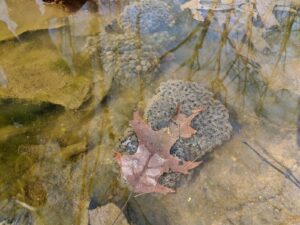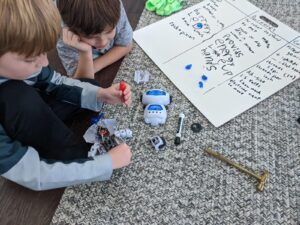Dispatches from the Distance Learning Trenches
October 13, 2020:
“We Wear the Mask”
From Karin Tooze, Upper School English, Washington International School (Adapted from the Washington International School’s “@WIS” community newsletter.)
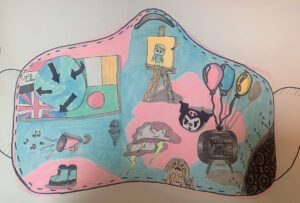
Karin Tooze, a new Upper School English teacher at the Washington International School, used making as a way to help her grade 10 students create an authentic connection to a poem they were studying, while also building a foundation for establishing relationships in the classroom–always a key part of the first days of school, but even more important in this time of distance learning.
As an introduction to their study of Octavia Butler’s novel Kindred, Karin and her students read Paul Laurence Dunbar’s poem “We Wear the Mask,” which focuses on former enslaved people hiding their pain behind smiles. Karin, inspired by her colleague Nick Loewen (an active member of our DCPZ network), asked the students, “What kinds of things does the speaker keep in front of, or ‘wear,’ on the mask, and what does he keep behind his mask?” She then asked the students to consider these questions for themselves: “How many times do we hide behind things? What sort of masks do we wear with others? What do we keep on the inside?” Then, as a way for the students to introduce themselves to each other (and to her), Karin asked them to answer questions about themselves, their place in history, the way others might view them, and something few people know about them.

From the answers to these questions, Karin asked her students to create their own mask: “They used their creativity to color and put things on the outside of the mask that they thought represented them or what people knew about them. Those could have been words, images, whatever. I also asked them to decorate the inside of the mask with things that they didn’t show the world, but I said they didn’t have to share those images publicly if they didn’t want to. Also, I wanted them to physically create this mask to give them time off their screens!” After they uploaded their masks to their class Padlet and discussed them as a class, each student was asked to write a poem about oneself, using the answers to the above questions and their mask as a guide.
While in the past she might have used a different template, this year Karin thought it was appropriate to use a template that looked like the masks we have all begun to wear as a response to the COVID-19 pandemic. It was a clever way to tie this older poem to our present-day reality, and also served to help Karin learn more about her students as individuals.
“Making with Our Feelings”
From Monica Caetano, Kindergarten Spanish immersion teacher, Washington International School
Monica Caetano also used making in a virtual setting as a way to build community in her Kindergarten classroom. In a conversation about feelings, she invited her students to share “happy experiences.” She said this helped students start to explore varied perspectives among their classmates, and ensured that everyone participated and got to know each other in a positive way.
She then gave them the instruction to make “our happy face” with materials they had at home. “We had a lot of fun, listening and making our free design of our favorite feeling!” she said. Below are the results!
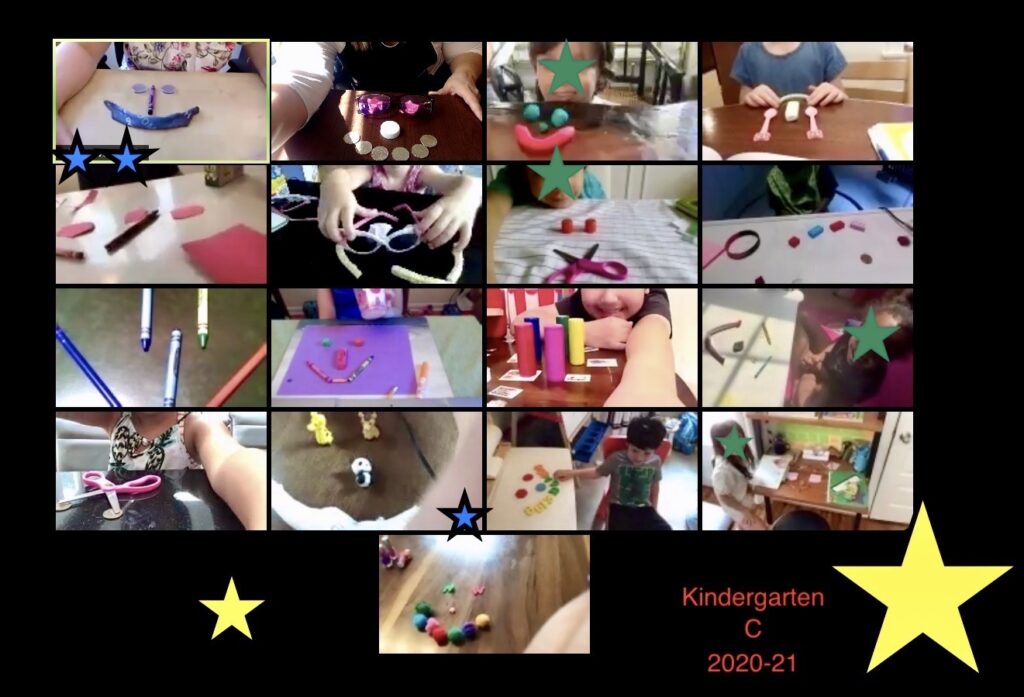
“Empowered to Hope: The Power of Making”
From Agnes Gómez, 5th grade teacher at the Sacred Heart Bilingual School in Washington, DC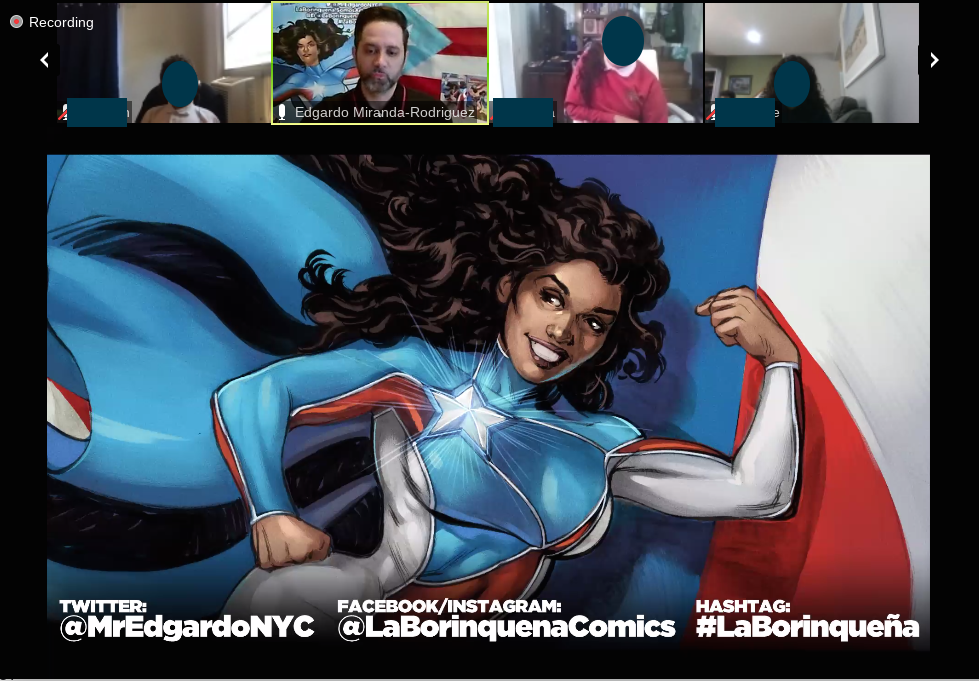
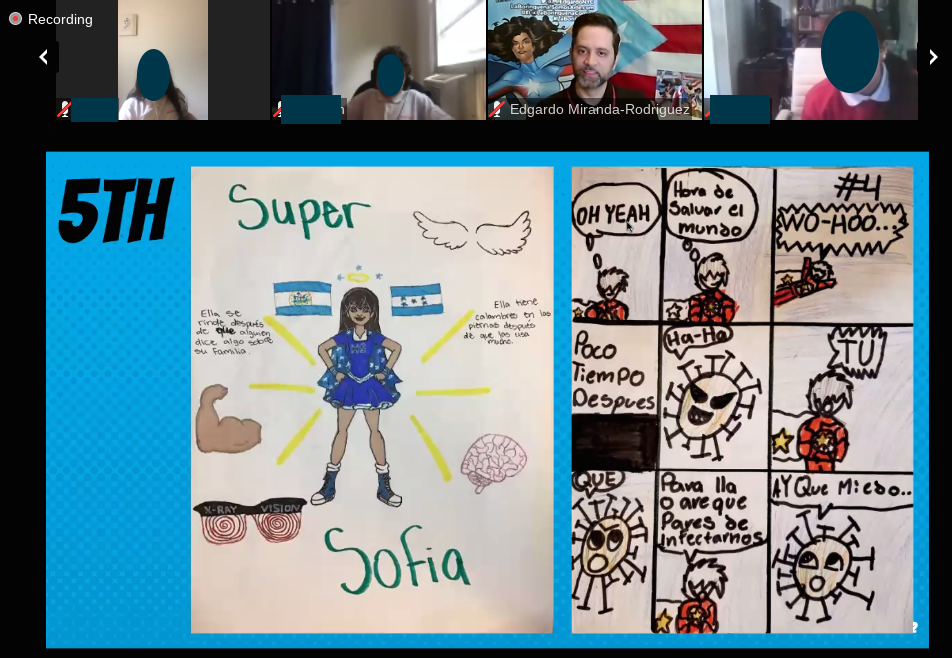
“Crazy Hat Day”
From Teresa Baeza, Middle and Upper School Spanish Teacher and Middle School Advisor at Washington International School (WIS)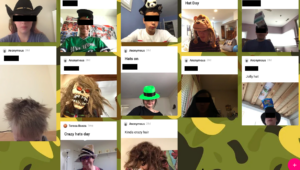
“Environmental Science Goes Indoors”
From Aleah Myers, Environmental Science teacher from Roosevelt High School (DCPS)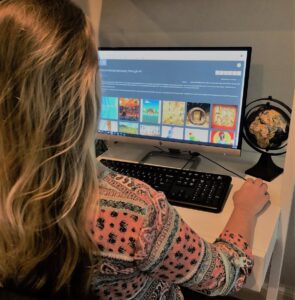 Springtime in my Environmental Science class usually equates to outdoor experiential learning: from going on field trips to test the water quality of the Potomac, to hiking from our campus to Rock Creek Park to plant native trees and remove invasive species, to taking advantage of our outdoor classroom and identifying the denizens of our school’s grounds. Teaching and learning about our planet as it is reborn each year is an experience unlike any other!
During the initial weeks of teaching from home, I struggled to redesign my curriculum in a way that best served all of my students, many of whom entered into distance learning without Wi-Fi or a device with which to learn virtually. As my district has worked to connect all students to technology and provide access to the internet, I am now facing a new challenge: How can I design lessons about our planet that can be presented asynchronously, are aligned to the learning packets being provided by my district, and are engaging so that students actually want to spend their time on them?
To address this question, I’ve found myself turning to what have always been my go-to resources: The Smithsonian Learning Lab and Project Zero Thinking Routines. In the coming weeks, we will See, Think and Wonder about coral reefs and plastic pollution; craft and support claims and Headlines about the invasive nutria’s impact on the Chesapeake Bay; and Imagine If… our neighborhoods were more sustainable. Even though the current circumstances are not ideal, I feel that I am still able to provide my students with equitable and meaningful independent learning experiences. My hope is to continue to foster my students’ creativity, critical thinking skills, and love of nature, even though Environmental Science class has been moved indoors.
Springtime in my Environmental Science class usually equates to outdoor experiential learning: from going on field trips to test the water quality of the Potomac, to hiking from our campus to Rock Creek Park to plant native trees and remove invasive species, to taking advantage of our outdoor classroom and identifying the denizens of our school’s grounds. Teaching and learning about our planet as it is reborn each year is an experience unlike any other!
During the initial weeks of teaching from home, I struggled to redesign my curriculum in a way that best served all of my students, many of whom entered into distance learning without Wi-Fi or a device with which to learn virtually. As my district has worked to connect all students to technology and provide access to the internet, I am now facing a new challenge: How can I design lessons about our planet that can be presented asynchronously, are aligned to the learning packets being provided by my district, and are engaging so that students actually want to spend their time on them?
To address this question, I’ve found myself turning to what have always been my go-to resources: The Smithsonian Learning Lab and Project Zero Thinking Routines. In the coming weeks, we will See, Think and Wonder about coral reefs and plastic pollution; craft and support claims and Headlines about the invasive nutria’s impact on the Chesapeake Bay; and Imagine If… our neighborhoods were more sustainable. Even though the current circumstances are not ideal, I feel that I am still able to provide my students with equitable and meaningful independent learning experiences. My hope is to continue to foster my students’ creativity, critical thinking skills, and love of nature, even though Environmental Science class has been moved indoors.
“Virtual Preschool”
From Georgina Ardalan, Kirsten Gnau, and Elizabeth Wyrsch (J. O. Wilson Elementary School, DCPS) “Virtual preschool” seemed like an oxymoron two weeks ago, but has since become a reality. At the start, we had a lot of questions. Honestly, we still do. How do we instill the most important lesson of preschool–socialization–without actually being physically present with a group of students? How do we best support our families in providing authentic, open-ended learning opportunities for their children? Through trial and error, we’re beginning to identify strategies that address these questions.
“Virtual preschool” seemed like an oxymoron two weeks ago, but has since become a reality. At the start, we had a lot of questions. Honestly, we still do. How do we instill the most important lesson of preschool–socialization–without actually being physically present with a group of students? How do we best support our families in providing authentic, open-ended learning opportunities for their children? Through trial and error, we’re beginning to identify strategies that address these questions.
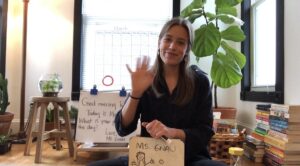 On Mondays, we’ve hosted live morning meetings to ensure that children are maintaining close relationships with their friends and teachers and to introduce our weekly provocation. Last week, we invited children to write thank you notes to all of the helpers in our city, like health care professionals, grocery store clerks, and mail carriers and post them in their windows.
We’ve sent frequent check-in emails to families, linking them to exciting resources, sending YouTube videos to pre-recorded read alouds, or just seeing how everyone is doing. We’ve also video-chatted with individual children who are missing their teachers and facilitated Marco Polo playdates for children missing their friends. Throughout the week, we’ve invited families to send us updates, pictures, or provocations of their own. And, on Fridays, we’ve sent out a newsletter recapping the week.
Since beginning “virtual preschool,” we are constantly adjusting, collaborating with our colleagues, asking for feedback from the families, and adjusting again. Having received massive support from our preschool families, we know that maintaining a successful virtual model will rely heavily on our partnership with them.
On Mondays, we’ve hosted live morning meetings to ensure that children are maintaining close relationships with their friends and teachers and to introduce our weekly provocation. Last week, we invited children to write thank you notes to all of the helpers in our city, like health care professionals, grocery store clerks, and mail carriers and post them in their windows.
We’ve sent frequent check-in emails to families, linking them to exciting resources, sending YouTube videos to pre-recorded read alouds, or just seeing how everyone is doing. We’ve also video-chatted with individual children who are missing their teachers and facilitated Marco Polo playdates for children missing their friends. Throughout the week, we’ve invited families to send us updates, pictures, or provocations of their own. And, on Fridays, we’ve sent out a newsletter recapping the week.
Since beginning “virtual preschool,” we are constantly adjusting, collaborating with our colleagues, asking for feedback from the families, and adjusting again. Having received massive support from our preschool families, we know that maintaining a successful virtual model will rely heavily on our partnership with them.
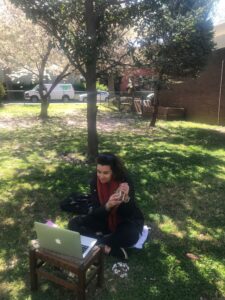 We miss the children and their families. We miss school. But, we understand the importance of why we are staying home. For now, we’ll continue to try out ideas that support relationship-building and authentic learning and that work well for our children and families.
We miss the children and their families. We miss school. But, we understand the importance of why we are staying home. For now, we’ll continue to try out ideas that support relationship-building and authentic learning and that work well for our children and families.
“Homeschooling during a Global Pandemic”
From Steve Eno (former Science and Engineering teacher at McDonogh School in Baltimore, MD, now a homeschool teacher for his two sons) 